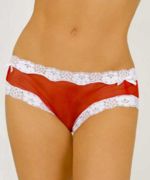Panties

Panties or knickers are female lingerie covering the hips and crotch, sometimes also the waist.
Contents[hide] |
Types of panties
A wide variety of types of panties exist. Bikini panties are designed so that the hip connectors are small, like on those often found in bikinis. String bikini panties are the most commonly worn type in the United States and are similar to regular bikini panties, but instead of a thin hip grip, they have a small string, which sometimes ties around the waist rather than being pulled up over them. String bikinis are considered more revealing. String bikinis are usually made of satin or silk, but occasionally from other fabrics. High-cut, or control top, are cut higher on the hip to slightly pull in and shape the stomach to conceal obesity. High-cut are usually worn by older women and are often shunned by younger women. Boyshorts describe a type of female underwear that has a lower, thicker cut of material around the hips, making them appear like shorts that men would wear. They are sometimes criticized by men and women alike for not being feminine, although some women do wear them.
Panties are made of a variety of materials and fabrics including satin, silk, PVC, cotton, nylon, mesh, lace, leather, latex, lycra and/or polyester. In recent years, they have increasingly been made of stretchable materials incorporating spandex, allowing them to fit better.
The term knickers is not generally used in the USA and Canada, where the term "panties" is usually favoured.
History

Before recent times, women's undergarments were often made with the primary function of moulding the body into a preferred shape (corsets etc). In Victorian times, women sometimes wore "drawers" (loose-fitting linen shorts with legs), but only as one of a number of layers of underwear. During much of the 1920s-1940s, women's undergarments came to be much less confining overall, but lower undergarments often continued to have legs (the "knickers" in "don't get your knickers in a twist"). In the mid 20th-century, tight-fitting girdles came to predominate.
In the 1940s, Frederick's of Hollywood opened shop in Hollywood, California and began selling corsets and lingerie with a much more fashionable appeal to them. These new styles of women's undergarments possessed a greater sexual feel, made even more glamourised by models such as Bettie Page. Colourful, bright, sexy, and flashier fashions of women's lingerie were becoming available. More fabrics such as satin, lace and silk began to be incorporated into the make-up of women's lingerie, making them more desired by females and more sensual to males. This is perhaps the great turning point, when panties became more than simple hygiene products and developed into an icon of pleasure and sexuality worldwide.
In the mid-to-late 1960s, girdles gave way to legless panties as the ordinary everyday underwear worn by the majority of Western women. Feminist women generally approved of this change, often viewing girdles as the last lingering remnant of cumbersome constricting Victorian corsetry, whose purpose was to impose control over and artificially distort the shape of women's figures. This was part of the meaning of the famous 1968 Miss America protest, which launched the incipient radical feminist movement into public consciousness. The new unconstraining undergarments could be seen as accommodating women's "natural" anatomy.
However, feminists were not necessarily enamoured of the next trend in women's undergarments: Beginning in the 1970s (reflecting the "sexual revolution" of that time), women's undergarments have tended to get ever-skimpier and more sexualized, and sometimes more publicly visible. In the 1980s, under the influence of trend-setters such as the singer Madonna, undergarments began to be more commonly visible from the outside of women's clothing. By the late 1990's, young and adventurous women often wore thongs, and the so-called "whale tail" was often exposed to view.
Current cultural significance
Since panties are the garment which is worn directly over the vulva, and one which is not fully visible unless a woman is partially undressed, they have always had sexual connotations.
In recent decades, women in flattering and provocative panties and lingerie have become a staple of several functions of men's and lesbians' popular culture. Several men's magazines such as Maxim and FHM often use images of attractive females in sensual lingerie to capture mainstream appeal (see Pin-up).
In today's society, panties have become an item of great interest in themselves. Considered by some to be risqué, panties have caused the lingerie industry to take advantage of their erotic associations. Lingerie chains such as Victoria's Secret and Frederick's of Hollywood hold annual modelling shows to showcase new varieties of panties and other assorted lingerie.
An erotic interest in panties which to some degree displaces an erotic focus on women themselves is known as Panty fetishism.
A number of non-nude pornography websites survive through selling photo sets of women posing in panties and other lingerie.
In most modern cultures, panties have become a bit of a cultural icon describing sexual mischief and a fun way of life, especially for teenage girls and women in their early twenties who are more likely to enjoy them than women who grew up wearing granny panties. In Japan, panties (pantsu) are commonly depicted as being a highly flirtatious, naughty element to a female's persona.
When a girl's skirt comes up high enough for her panties to be seen, it is called an 'upskirt' or 'panty shot'. Many websites on the internet make profits from selling the aforementioned kind of pornography or voyeurism.
Panties in bondage
When gagging a female, it is commonplace in stories to use a stuff gag where the stuffing is the victim's own panties. If there are two victims, they may be made to swap panties. Covering the victim's head with panties may be an effective blindfold.
See also
- Boxer shorts
- Briefs
- Drawers
- Bloomers
- Lingerie
- Panchira
- Panty fetishism
- Panty shot
- Thong (lingerie)
- Tanga
- Crotchless clothing
| This page uses content from SM-201; the original article can be viewed here. |
